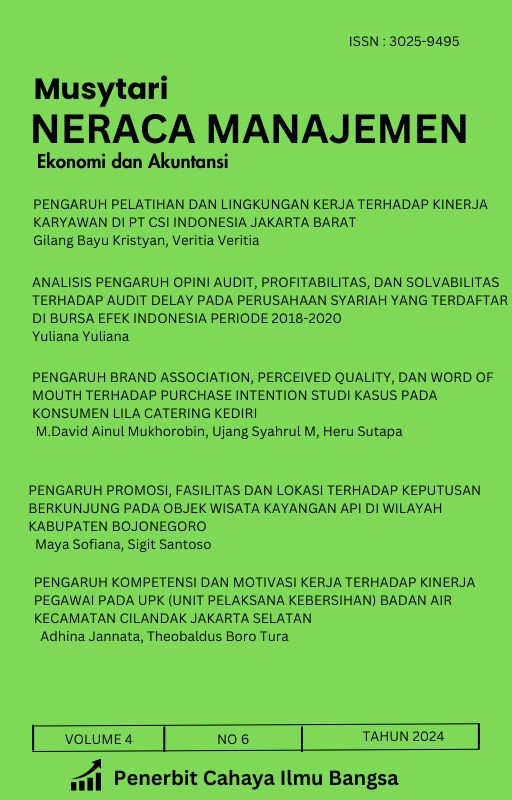STRATEGI, INOVASI, DAN KINERJA DALAM DINAMIKA PERSAINGAN PASAR
Main Article Content
Abstract
Artikel ini bertujuan untuk mengkaji hubungan antara strategi bisnis, inovasi, dan kinerja organisasi melalui pendekatan tinjauan literatur. Strategi bisnis memberikan kerangka kerja bagi perusahaan untuk membangun keunggulan kompetitif, sedangkan inovasi berperan sebagai pendorong yang memperkuat implementasi strategi dalam merespons perubahan lingkungan eksternal. Integrasi antara strategi dan inovasi menunjukkan dampak signifikan terhadap peningkatan kinerja, baik secara finansial maupun non-finansial. Dalam proses tersebut, kapabilitas dinamis menjadi elemen penting yang memungkinkan perusahaan untuk merasakan peluang, menangkap peluang, dan mentransformasi sumber daya mereka. Namun, tantangan seperti kesenjangan antara formulasi dan implementasi strategi seringkali menghambat keberhasilan integrasi tersebut. Artikel ini memberikan wawasan bagi perusahaan dalam memanfaatkan hubungan sinergis antara strategi, inovasi, dan kinerja untuk membangun keunggulan kompetitif yang berkelanjutan.
This article pursues examining the relationship between business strategy, innovation, and organizational performance through a literature review avenue. Business strategy provides a framework for firms to build competitive advantage while innovation acts as a catalysis that strengthens the implementation of such strategies in response to external environmental changes. The integration of strategy and innovation significantly impacts performance improvement; for that matter, dynamic capabilities act as a combination of seeing an opportunity, grabbing the opportunity, and transforming resources to manage the opportunity. Such constraints as strategy misalignment between formulation and implementation tend to chip away at prospects for success in this case. This article spells out what corporations could actualize by that the synergy-made-to-last between strategy, innovation, and performance creates in achieving sustainable competitive advantage
Downloads
Article Details

This work is licensed under a Creative Commons Attribution-NonCommercial 4.0 International License.
This work is licensed under a Creative Commons Attribution-ShareAlike 4.0 International License.
References
Alatawi, I. A., Ntim, C. G., Zras, A., & Elmagrhi, M. H. (2023). CSR, financial and non-financial performance in the tourism sector: A systematic literature review and future research agenda. International Review of Financial Analysis, 102734.
Braun, V., & Clarke, V. (2022). Conceptual and design thinking for thematic analysis. Qualitative Psychology, 9(1), 3.
Candido, C. J., & Santos, S. P. (2019). Implementation obstacles and strategy implementation failure. Baltic Journal of Management, 14(1), 39–57.
Chirumalla, K. (2021). Building digitally-enabled process innovation in the process industries: A dynamic capabilities approach. Technovation, 105, 102256.
Cullen, L., Hanrahan, K., Farrington, M., Tucker, S., & Edmonds, S. (2022). Evidence-based practice in action: Comprehensive strategies, tools, and tips from University of Iowa Hospitals & Clinics. Sigma Theta Tau.
Fader, P. (2020). Customer centricity: Focus on the right customers for strategic advantage. University of Pennsylvania Press.
Farida, I., & Setiawan, D. (2022). Business strategies and competitive advantage: The role of performance and innovation. Journal of Open Innovation: Technology, Market, and Complexity, 8(3), 163.
Ferreira, J. J., Fernandes, C. I., & Ferreira, F. A. (2019). To be or not to be digital, that is the question: Firm innovation and performance. Journal of Business Research, 101, 583–590.
George, B., Walker, R. M., & Monster, J. (2019). Does strategic planning improve organizational performance? A meta‐analysis. Public Administration Review, 79(6), 810–819.
Hartono, A., & Kusumawardhani, R. (2019). Innovation barriers and their impact on innovation: Evidence from Indonesian manufacturing firms. Global Business Review, 20(5), 1196–1213.
Hou, B., Hong, J., & Zhu, R. (2019). Exploration/exploitation innovation and firm performance: The mediation of entrepreneurial orientation and moderation of competitive intensity. Journal of Asia Business Studies, 13(4), 489–506.
Hunt, S. D., & Madhavaram, S. (2020). Adaptive marketing capabilities, dynamic capabilities, and renewal competences: The “outside vs. Inside” and “static vs. Dynamic” controversies in strategy. Industrial Marketing Management, 89, 129–139.
Klein, V. B., & Todesco, J. L. (2021). COVID‐19 crisis and SMEs responses: The role of digital transformation. Knowledge and Process Management, 28(2), 117–133.
Langroodi, F. E. (2021). Schumpeter’s theory of economic development: A study of the creative destruction and entrepreneurship effects on the economic growth. Journal of Insurance and Financial Management, 4(3).
Le, T. T., & Ikram, M. (2022). Do sustainability innovation and firm competitiveness help improve firm performance? Evidence from the SME sector in Vietnam. Sustainable Production and Consumption, 29, 588–599.
O’Dea, R. E., Lagisz, M., Jennions, M. D., Koricheva, J., Noble, D. W., Parker, T. H., & Nakagawa, S. (2021). Preferred reporting items for systematic reviews and meta‐analyses in ecology and evolutionary biology: A PRISMA extension. Biological Reviews, 96(5), 1695–1722.
Przychodzen, W., Leyva-de la Hiz, D. I., & Przychodzen, J. (2020). First‐mover advantages in green innovation—Opportunities and threats for financial performance: A longitudinal analysis. Corporate Social Responsibility and Environmental Management, 27(1), 339–357.
Purba, J. T., Gumulya, D., Hariandja, E., & Pramono, R. (2023). Valuable, rare, inimitable, non-substitutable of resources in building innovation capability for sustainable development: Evidence from creative social enterprises. Nternational Journal of Sustainable Development & Planning, 18(2).
Rabelino, R., Kohtamaki, M., & Federico, J. S. (2021). A (re)view of the philosophical foundations of strategic management. International Journal of Management Reviews, 23(2), 151–190.
Segers, J.-P., & Gaile-Sarkane, E. (2020). From creative destruction to creative disruption: Lessons for selected and strategic industries. Innovation and Technology Transfer in Emerging Economies.
Snyder, H. (2019). Literature review as a research methodology: An overview and guidelines. Journal of Business Research, 104, 333–339.
Subrahmanyam, S. (2019). Carrefour’s competitive strategy-cost leadership and differentiation: A case study. Pacific Business Review International, 11(8).
Tidd, J., & Bessant, J. R. (2020). Managing innovation: Integrating technological, market and organizational change. John Wiley & Sons.
Van, I. N., Le, T. T., & Kotaskova, A. (2023). The role of brand and market orientation on competitive advantage in the food sector: Business strategy’s moderator role. British Food Journal, 125(11), 3888–3911.
Warner, K. S., & Wager, M. (2019). Building dynamic capabilities for digital transformation: An ongoing process of strategic renewal. Long Range Planning, 52(3), 326–349.

